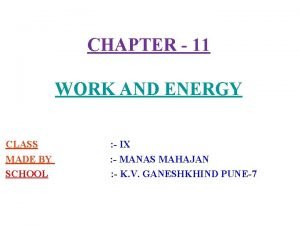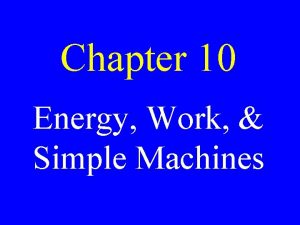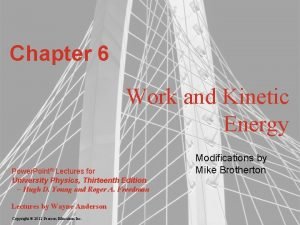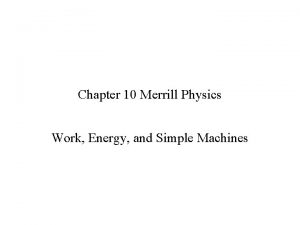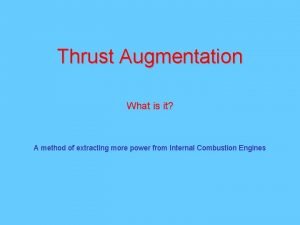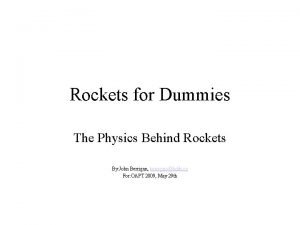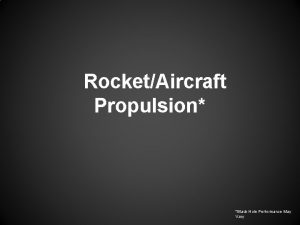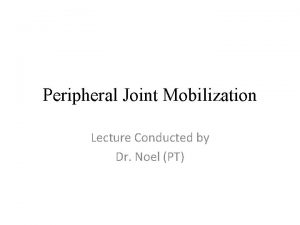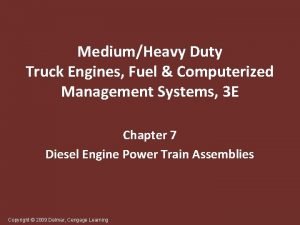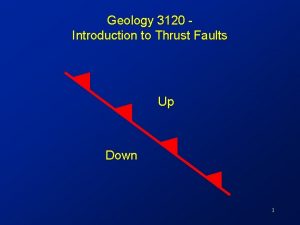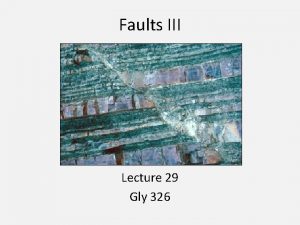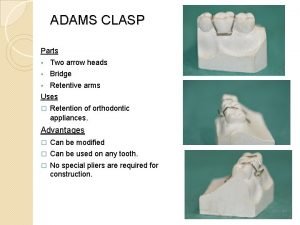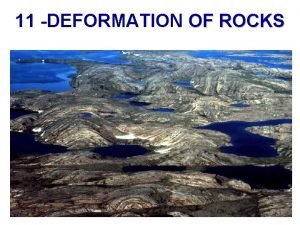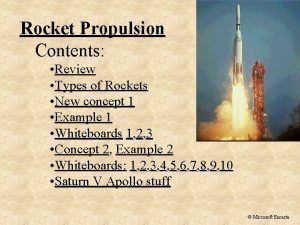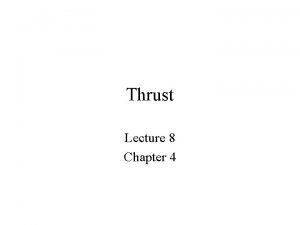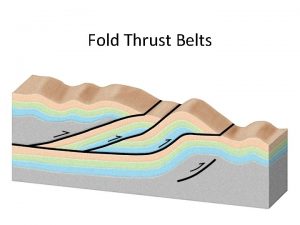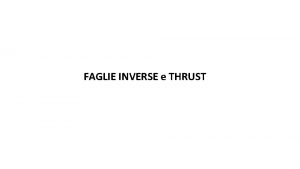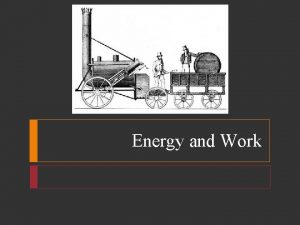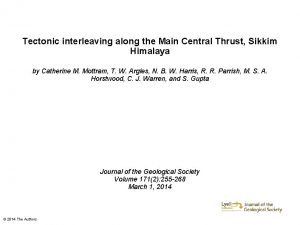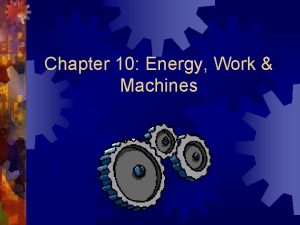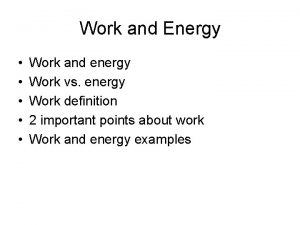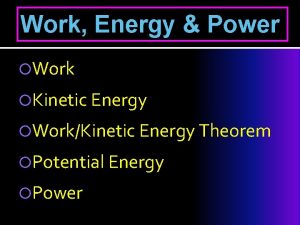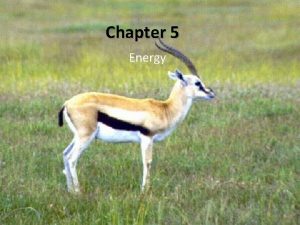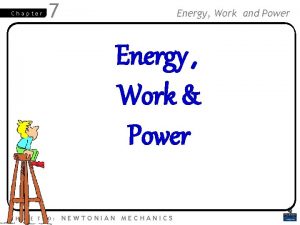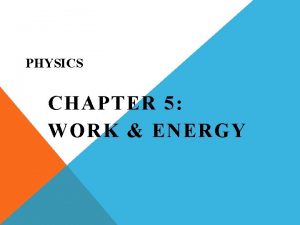Chapter 6 Work and Energy Main thrust Work













































- Slides: 45

Chapter 6 Work and Energy

Main thrust • Work done by a constant force – Projection, Scalar product (force that result in positive work). – negative work? , force that does no work? • Work done by varying force with displacement

6. 1 Work Done by a Constant Force

6. 1 Work Done by a Constant Force

Work, cont. • W = F Dr cos q – The displacement is that of the point of application of the force. – A force does no work on the object if the force does not move through a displacement. – The work done by a force on a moving object is zero when the force applied is perpendicular to the displacement of its point of application. Section 7. 2

6. 1 Work Done by a Constant Force

6. 1 Work Done by a Constant Force Example 1 Pulling a Suitcase-on-Wheels Find the work done if the force is 45. 0 -N, the angle is 50. 0 degrees, and the displacement is 75. 0 m.

6. 1 Work Done by a Constant Force

6. 1 Work Done by a Constant Force Example 3 Accelerating a Crate The truck is accelerating at a rate of +1. 50 m/s 2. The mass of the crate is 120 -kg and it does not slip. The magnitude of the displacement is 65 m. What is the total work done on the crate by all of the forces acting on it?

6. 1 Work Done by a Constant Force The angle between the displacement and the friction force is 0 degrees.

6. 2 The Work-Energy Theorem and Kinetic Energy Consider a constant net external force acting on an object. The object is displaced a distance s, in the same direction as the net force. The work is simply

6. 2 The Work-Energy Theorem and Kinetic Energy DEFINITION OF KINETIC ENERGY The kinetic energy KE of and object with mass m and speed v is given by

6. 2 The Work-Energy Theorem and Kinetic Energy THE WORK-ENERGY THEOREM When a net external force does work on and object, the kinetic energy of the object changes according to

6. 2 The Work-Energy Theorem and Kinetic Energy Example 4 Deep Space 1 The mass of the space probe is 474 -kg and its initial velocity is 275 m/s. If the 56. 0 -m. N force acts on the probe through a displacement of 2. 42× 109 m, what is its final speed?

6. 2 The Work-Energy Theorem and Kinetic Energy

6. 2 The Work-Energy Theorem and Kinetic Energy

6. 2 The Work-Energy Theorem and Kinetic Energy In this case the net force is

6. 2 The Work-Energy Theorem and Kinetic Energy Conceptual Example 6 Work and Kinetic Energy A satellite is moving about the earth in a circular orbit and an elliptical orbit. For these two orbits, determine whether the kinetic energy of the satellite changes during the motion.

6. 3 Gravitational Potential Energy

6. 3 Gravitational Potential Energy

6. 3 Gravitational Potential Energy Example 7 A Gymnast on a Trampoline The gymnast leaves the trampoline at an initial height of 1. 20 m and reaches a maximum height of 4. 80 m before falling back down. What was the initial speed of the gymnast?

6. 3 Gravitational Potential Energy

6. 3 Gravitational Potential Energy DEFINITION OF GRAVITATIONAL POTENTIAL ENERGY The gravitational potential energy PE is the energy that an object of mass m has by virtue of its position relative to the surface of the earth. That position is measured by the height h of the object relative to an arbitrary zero level:

6. 4 Conservative Versus Nonconservative Forces DEFINITION OF A CONSERVATIVE FORCE Version 1 A force is conservative when the work it does on a moving object is independent of the path between the object’s initial and final positions. Version 2 A force is conservative when it does no work on an object moving around a closed path, starting and finishing at the same point.

6. 4 Conservative Versus Nonconservative Forces

6. 4 Conservative Versus Nonconservative Forces Version 1 A force is conservative when the work it does on a moving object is independent of the path between the object’s initial and final positions.

6. 4 Conservative Versus Nonconservative Forces Version 2 A force is conservative when it does no work on an object moving around a closed path, starting and finishing at the same point.

6. 4 Conservative Versus Nonconservative Forces An example of a nonconservative force is the kinetic frictional force. The work done by the kinetic frictional force is always negative. Thus, it is impossible for the work it does on an object that moves around a closed path to be zero. The concept of potential energy is not defined for a nonconservative force.

6. 4 Conservative Versus Nonconservative Forces In normal situations both conservative and nonconservative forces act simultaneously on an object, so the work done by the net external force can be written as

6. 4 Conservative Versus Nonconservative Forces THE WORK-ENERGY THEOREM

6. 5 The Conservation of Mechanical Energy If the net work on an object by nonconservative forces is zero, then its energy does not change:

6. 5 The Conservation of Mechanical Energy THE PRINCIPLE OF CONSERVATION OF MECHANICAL ENERGY The total mechanical energy (E = KE + PE) of an object remains constant as the object moves, provided that the net work done by external nononservative forces is zero.

6. 5 The Conservation of Mechanical Energy

6. 5 The Conservation of Mechanical Energy Example 8 A Daredevil Motorcyclist A motorcyclist is trying to leap across the canyon by driving horizontally off a cliff 38. 0 m/s. Ignoring air resistance, find the speed with which the cycle strikes the ground on the other side.

6. 5 The Conservation of Mechanical Energy

6. 5 The Conservation of Mechanical Energy

6. 5 The Conservation of Mechanical Energy Conceptual Example 9 The Favorite Swimming Hole The person starts from rest, with the rope held in the horizontal position, swings downward, and then lets go of the rope. Three forces act on him: his weight, the tension in the rope, and the force of air resistance. Can the principle of conservation of energy be used to calculate his final speed?

6. 6 Nonconservative Forces and the Work-Energy Theorem THE WORK-ENERGY THEOREM

6. 6 Nonconservative Forces and the Work-Energy Theorem Example 11 Fireworks Assuming that the nonconservative force generated by the burning propellant does 425 J of work, what is the final speed of the rocket. Ignore air resistance.

6. 6 Nonconservative Forces and the Work-Energy Theorem

6. 7 Power DEFINITION OF AVERAGE POWER Average power is the rate at which work is done, and it is obtained by dividing the work by the time required to perform the work.

6. 7 Power

6. 7 Power

6. 8 Other Forms of Energy and the Conservation of Energy THE PRINCIPLE OF CONSERVATION OF ENERGY Energy can neither be created not destroyed, but can only be converted from one form to another.

6. 9 Work Done by a Variable Force Constant Force Variable Force
 Section 4 review physical science
Section 4 review physical science Thrust reverser
Thrust reverser Energy energy transfer and general energy analysis
Energy energy transfer and general energy analysis Energy energy transfer and general energy analysis
Energy energy transfer and general energy analysis Section 1 work and machines section 2 describing energy
Section 1 work and machines section 2 describing energy Physics 03-01 work and the work-energy theorem
Physics 03-01 work and the work-energy theorem Tell more about the main idea
Tell more about the main idea Stage position names
Stage position names Head tilt chin lift jaw thrust
Head tilt chin lift jaw thrust Traverse stage cons
Traverse stage cons Irregular verb infinitive
Irregular verb infinitive Chapter 11 work and energy
Chapter 11 work and energy Chapter 10 energy, work and simple machines answer key
Chapter 10 energy, work and simple machines answer key Chapter 10 energy, work and simple machines answer key
Chapter 10 energy, work and simple machines answer key Energy work and simple machines chapter 10 answers
Energy work and simple machines chapter 10 answers Chapter 6 work and energy powerpoint
Chapter 6 work and energy powerpoint Chapter 10 energy work and simple machines answer key
Chapter 10 energy work and simple machines answer key Chapter 7 energy conservation of energy
Chapter 7 energy conservation of energy Future with will
Future with will Void main int main
Void main int main Steering axis inclination
Steering axis inclination Thrust augmentation methods
Thrust augmentation methods Proscenium thrust stage
Proscenium thrust stage Contoh panggung thrust
Contoh panggung thrust Traverse stage
Traverse stage Cummies rocket
Cummies rocket Specific thrust equation
Specific thrust equation Chamber nozzle
Chamber nozzle Non-thrust oscillation techniques
Non-thrust oscillation techniques Non-thrust oscillation techniques
Non-thrust oscillation techniques Lift drag thrust weight
Lift drag thrust weight Thrust side
Thrust side Clamshell door thrust reverser
Clamshell door thrust reverser Kounin 1970
Kounin 1970 Thrust geology
Thrust geology Strike in geology
Strike in geology Fault bend fold
Fault bend fold Lift drag thrust weight
Lift drag thrust weight Throw and heave of fault
Throw and heave of fault Blind thrust fault animation
Blind thrust fault animation Triangular clasp uses
Triangular clasp uses Thrust to weight ratio formula
Thrust to weight ratio formula Overturned syncline
Overturned syncline Strike slip fault
Strike slip fault Thrust or trestle stage
Thrust or trestle stage Thrust of a rocket formula
Thrust of a rocket formula











